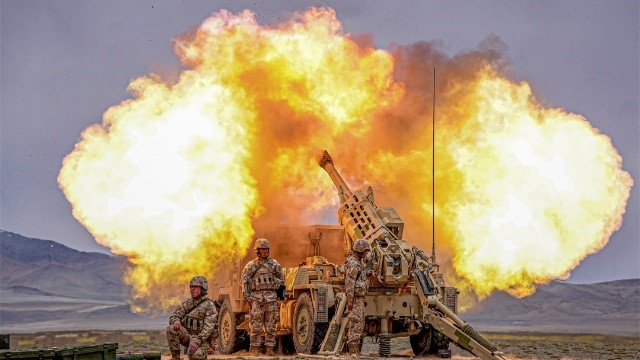President Xi’s bellicose language towards its neighbors and the United States is demonstrably backed up by sheer and undeniable military strength.
According to the U.S. Department of Defense, the PLA (China’s People’s Liberation Army) has sought to modernize its capabilities and improve its proficiencies across all warfare domains so that, as a joint force, it can conduct the full range of land, air, and maritime as well as nuclear, space, counterspace, electronic warfare (EW), and cyberspace operations. The PLA’s evolving capabilities and concepts continue to strengthen the PRC’s ability to “fight and win wars” against a “strong enemy” (a likely euphemism for the United States), counter an intervention by a third party in a conflict along the PRC’s periphery, and project power globally.
China continues to modernize equipment and focus on combined arms and joint training in effort to meet the goal of becoming a world class military. Beijing demonstrated a new long-range fire capability in the PLA military response to the August 2022 U.S. Congressional Delegation visit to Taiwan. It continues to incorporate a twice a year conscript intake.
The People’s Liberation Army Navy (PLAN) has numerically the largest navy in the world with an overall battle force of over 370 ships and submarines, including more than 140 major surface combatants. The PLAN is largely composed of modern multi-mission ships and submarines. In 2022, the PLAN launched its third aircraft carrier, CV-18 Fujian. ‒ It also commissioned its third YUSHEN class Amphibious Assault Ships) and has likely begun construction on a fourth as of early 2023. In the near-term, the PLAN will have the ability to conduct long-range precision strikes against land targets from its submarine and surface combatants using land-attack cruise missiles, notably enhancing the PRC’s power projection capability. ‒ The PRC continues to challenge foreign military activities in its exclusive economic zone (EEZ) in a manner that is inconsistent with the rules of customary international law as reflected in the United Nations Convention on the Law of the Sea. At the same time, the PLAN conducts activities in the EEZs of other countries, including the United States, Australia, Philippines, Vietnam, and Malaysia.
The PLAAF and PLAN aviation together constitute the largest aviation force in the Indo-Pacific region. The PLAAF is rapidly catching up to western air forces. The PLAAF continues to modernize with the delivery of domestically built aircraft and a wide range of UASs. In October 2019, the PLAAF signaled the return of the airborne leg of its nuclear triad after the PLAAF publicly revealed the H-6N as its first nuclear-capable air-to-air refuelable bomber.
People’s Liberation Army Rocket Force (PLARF) is advancing its long-term modernization plans to enhance its ‘strategic deterrence’ capabilities. The PRC is developing new ICBMs that will significantly improve its nuclear-capable missile forces and will require increased nuclear warhead production, partially due to the introduction of multiple independently targetable reentry vehicle (MIRV) capabilities. The PRC may be exploring development of conventionally-armed intercontinental range missile systems. If developed and fielded, such capabilities would allow the PRC to threaten conventional strikes against targets in the continental United States, Hawaii, and Alaska.
Indeed, the Stockholm Peace Research Institute notes that “China possesses an estimated 410 nuclear warheads as of January 2023, which marks an increase of around 60 warheads from the previous year…it makes clear that China’s historical reliance on a “minimum deterrent” has markedly shifted. Moreover, additional Chinese warheads are expected in the future. Along with its warhead expansion, China is advancing its “nuclear triad,” consisting of land-based, sea-based, and air-based nuclear delivery systems.”
China’s scientists continue to pioneer innovative weapons systems. One example, as reported by SCMP Chinese military scientists have developed a science-fiction like energy shield.”
President Xi has admonished his nation to “focus all its energy on fighting.”
China’s growing preference for force and threats can be seen in its Taiwan and Hong Kong policies. In gaining control of Hong Kong through the 1984 Sino-British Joint Declaration, it agreed to conditions allowing Hong Kong to maintain existing structures of government and economy under a principle of “one country, two systems” for half a century. Had it adhered to that provision, it would have been a signal to Taiwan that Beijing’s goal of unification was peaceful and that it would respect local rights. In ignoring its Hong Kong obligations, it signaled that it would seek to takeover Taiwan by force.
The same can be said for Beijing’s attitude towards the rest of the world. It’s diplomats scold and threaten representatives of the nations it deals with, in a strategy known as “wolf diplomacy.”
Photo: Chinese force live-fire artillery training (China Defence Ministry)
